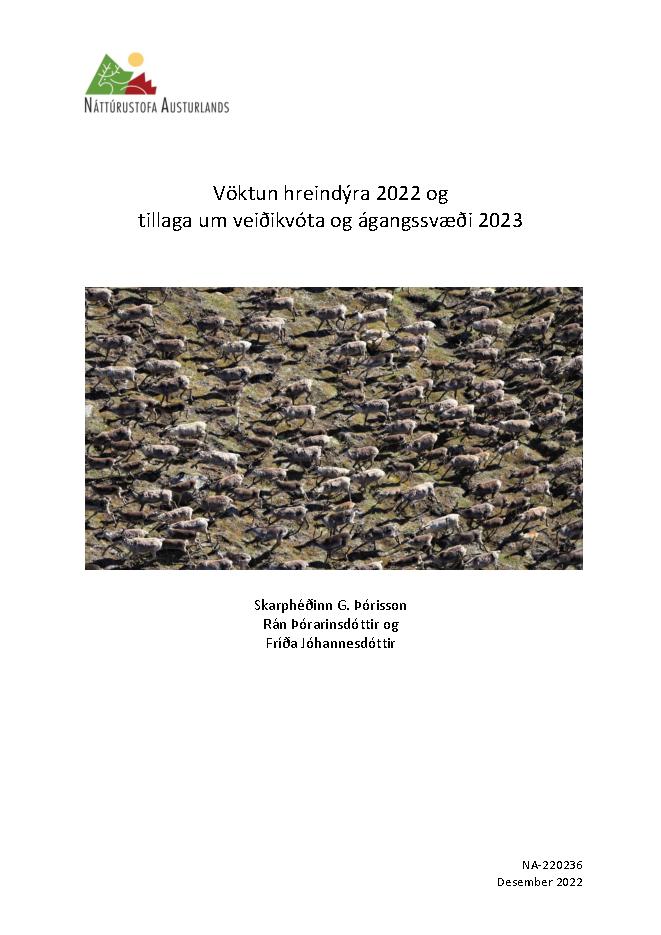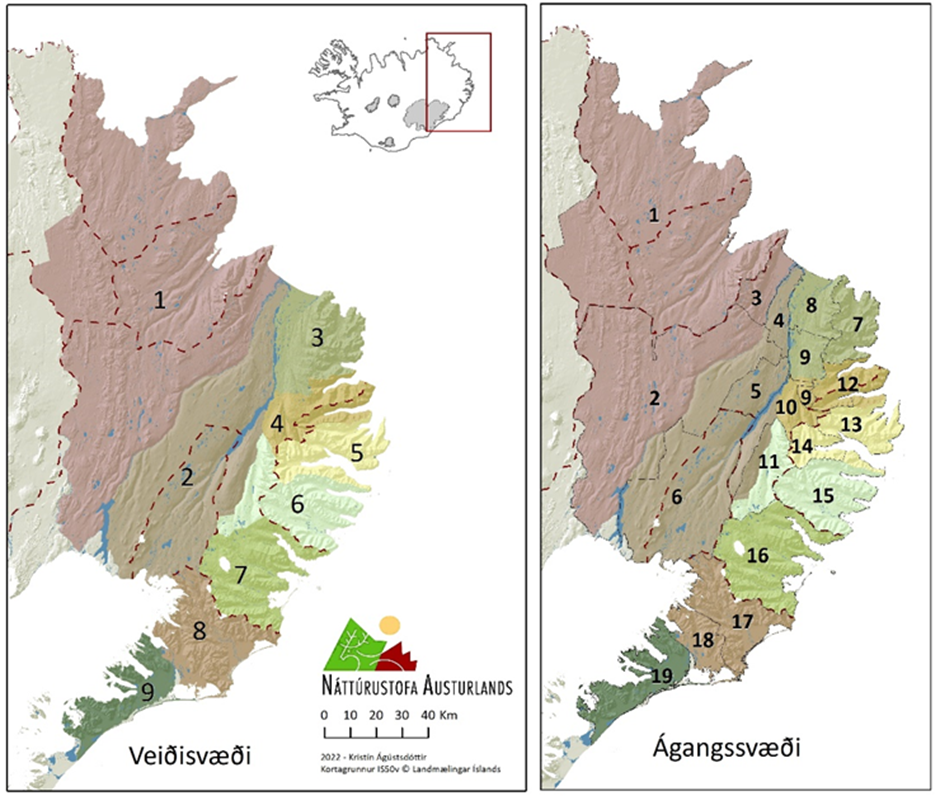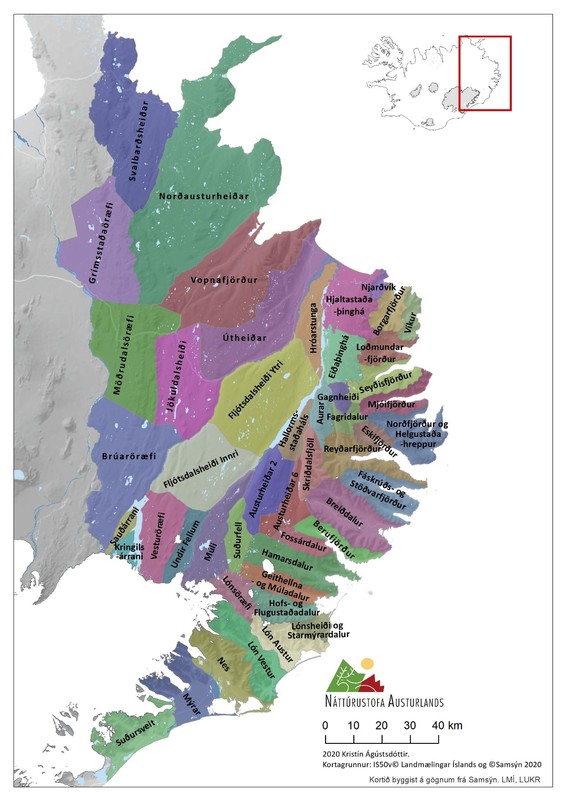Progress
Reindeer are found only in East Iceland, divided into nine reindeer hunting areas and 19 grazing areas (see Figure 1) and further divided into counting areas (see Figure 2). Snæfellsherd is the group of reindeer that spend the summer in the vicinity of the mountain Snæfell east and Hálslón reservoir. Snæfellsherd further splits into two sub herds: Norðurheiðaherd, located west and north of Jökulsá á Dal river and Hálslón reservoir (in hunting area 1), and Fljótsdalsherd, located east of the river (in hunting area 2). The status of Snæfellsherd is discussed here. The condition of the reindeer population in East Iceland is discussed in more detail in annual monitoring reports (Icelandic only) by the East Iceland Nature Research Centre (Náttúrustofa Austurlands). Among other things, it contains information about hunting, but by issuing permits to hunt from the stock every year, it is ensured that the number of reindeers in the herd does not increase too much. There is also information about changes in the dead weight of the animals, which tells, among other things, about growth in the stock and is an important part of its management.
Figure 1. Reindeer hunting areas and impact areas in East Iceland 2022. (Skarphéðinn G. Þórisson o.fl. 2022). (Ágangssvæði = impact area, Veiðisvæði = hunting area)
Figure 2. East Iceland is divided into many counting areas for monitoring purposes. Skarphéðinn G. Þórisson o.fl. 2022.
Figure 3. The smoothed averages (chain averages) of 3-year periods based on summer counts of the Snæfell herd from 1965 to 2022 and partially on rutting period counts in Norðurheiðar from 2009. Smoothed averages are often used to reduce the impact of inevitable inaccuracies in year-to-year counts, providing a clearer picture of the overall trend. No animals were found in hunting areas 1 and 2 during the summer counts of 2023.
Changes in the number of reindeer in Snæfellsherd since 1965:
- 1965-1976. Increase, the peak reached 1972 - 1976 (almost 3600 animals), no hunting 1965-1967 and 1970-1971.
- 1977-1984. Migration causes reduction, presumably due to herd migration to the fjords.
- 1985-1999. The number of animals is low (fluctuating between 1000-1500).
- 2000-2007. Increase until 2007, intentional reduction by hunting 2005.
- 2008 - 2020. Expansion to the east and north causes a decrease in summer counts in traditional areas in Snæfellsöræfi. The animals disappear from Kringilsárrani and Sauðárrani (Norðurheiðaherd). The number of animals in Fljótsdalsherd increased, especially in Vesturöræfi, but numbers in that area have come down again in recent years.
- 2021-2022. The decrease is thought to be due to increased migration of animals between hunting areas and possible overestimation in previous years.
The distribution and number of animals in Snæfellsöræfi during the summer had changed since 2000 when the main summer pastures moved from Vesturöræfi to Fljótsdalsheiði and ten years later to the nearby hunting area (areas 6 and 7). The number of animals increased in Vesturöræfi until 2018 (1159) but decreased after that, and no animals were found there in 2022. The decrease in the number of reindeer in Vesturöræfi is opposed to the development over recent years. It has reduced hopes that Vesturöræfi was gaining its former place as the main summer pasture for Fljótsdalsherd.
The overall result is that the number of animals in Snæfellsherd fluctuates between years mainly because they do not return to the area. To the west of Jökla, in Kringilsárrana and Sauðárrana, they had almost disappeared, compared to the July count, but have increased somewhat in recent years. More counts in the summer could reveal fluctuations in the number of animals on Snæfellsöræfi.
|
|
Múli |
Undir Fellum |
Vesturöræfi |
Fljótsdalsheiði |
W-Jökulsá á Dal |
Total |
|---|---|---|---|---|---|---|
|
2011 |
69 |
211 |
376 |
0 |
52 |
708 |
|
2012 |
87 |
582 |
281 |
0 |
236 |
1.186 |
|
2013 |
278 |
42 |
371 |
0 |
39 |
730 |
|
2014 |
239 |
50 |
559 |
0 |
36 |
884 |
|
2015 |
261 |
0 |
456 |
0 |
0 |
717 |
|
2016 |
384 |
0 |
702 |
0 |
26 |
1.112 |
|
2017 |
13 |
47 |
1 419 |
0 |
22 |
1.501 |
|
2018 |
92 |
12 |
1.112 |
0 |
25 |
1.241 |
|
2019 |
258 |
0 |
946 |
18 |
23 |
1.143 |
|
2020 |
140 |
129 |
284 |
55 |
32 |
640 |
|
2021 |
0 |
253 |
75 |
0 |
86 |
414 |
|
2022 |
166 |
110 |
0 |
0 |
111 |
387 |
The Engineering Research Institute of the University of Iceland was responsible for counting reindeer for Landsvirkjun from the air during the calving season north of the Brúarjökull glacier from 1993 until 2013 (See report from 2013: LV-2013/127 (Icelandic only)).
Since 2005, the East Iceland Nature Research Centre has monitored reindeer calving areas in the vicinity of the Kárahnjúkar hydropower construction area. During the first years, monitoring was carried out from land but in recent years, from the air and with the help of GPS devices.
In 2015, a report was published summarising data collected in calving areas over nine years (2005-2013) LV-2015/130 (Icelandic only), and in 2021, a report (Icelandic only) was published presenting the results of research from 2005-2020. The study revealed that fewer and fewer animals have lived in formerly known breeding areas closest to reservoirs, power plants, and other associated structures since 2009. In 2020, only 12% of the estimated number of cows were found in hunting area 2 in the breeding studies. The cows that remained in hunting area 2 in the spring of 2014-2020 seemed to be moving closer to the power plant structures in Vesturöræfi, but only in the rather snowy spring. The low calf ratios in July in hunting area 2 in the last years of the study (2018-2020) were a cause for concern, and it could not be ruled out that it was related to poorer access for purebred cows to good breeding areas. The fact that the lightest part of Vesturöræfi went under a reservoir could have made Vesturöræfi a more homogeneous option and are, therefore, probably not as suitable for carrying as before. It is also unclear what effect increased access to the area has had in connection with the power plant project. Still, the gestation period is when the cows are most vulnerable to disturbance, access to food is most limited, and calves are particularly sensitive. When disturbing the bearing area of a small population, an effect must be expected, although such an effect may take some time to develop. It is unclear where most cows from Hunting Area 2 have been in recent years, but it is essential to understand this better.
Since 2021, breeding areas have been mapped, and the counts have had varying success. Monitoring followed the traditional pattern in the breeding areas in the spring of 2023. After an unsuccessful breeding count flight in the spring of 2022, the 2023 breeding counts went well, particularly in hunting area 1, where GPS-collared cows were especially helpful. Up to 200 cows were found in hunting area 1 during the count, mainly around Ytri- and Syðri-Háganga, but animals were also located in Kringilsárrani and Sauðárrani. In hunting area 2, and just outside its borders in areas 7 and 8, more than 100 cows were found during the breeding counts. It cannot be ruled out that some groups were double-counted in these areas since the counts took place at two-week intervals.
Research on the distribution and grazing of reindeer in Snæfellsherd with GPS transmitters began in 2009 after the Kárahnjúkar power plant began operations. The first animals were tagged in 2009. Research on reindeer with GPS devices in 2009-2011 was published in the autumn of 2014 NA-140140 (Icelandic only). In connection with load-bearing research from 2014 to 2020, six new transmitters were installed on purebred cows in Snæfellsherd in 2017-2020, and they are reported here. At the beginning of 2023, only two cows had active GPS transmitters, but eight more cows were tagged in the spring of 2023. (NA-220236).
In recent years Landsvirkjun and the East Iceland Nature Research Centre have been adjusting the monitoring of vegetation and reindeer with increased emphasis on the integration of reindeer and vegetation studies, including the potential impact of the significant increase in the pink-footed goose in the area around Kárahnjúkar.
Raw data in excel is a document from The East Iceland Nature Research Center published with permission.
Updated: September 17, 2024
Source: The East Iceland Nature Research Center (2024)
Metrics, Targets and Monitoring Protocol
What is measured?
The number of reindeer and distribution of Snæfellsherd especially in Snæfellsöræfi wilderness i.e. Brúaröræfi wilderness, Vesturöræfi wilderness, Under Fellum, Múli and Hraun and Norðurheiðar (Impact of hydropower projects considered undirect in the latter two).
Monitoring Protocol
Direct counting and aerial photos taken in the first two weeks in July each summer are used to estimate the number of animals.
Targets
Not more than 15% decrease in the reindeer stock in Vesturöræfi wilderness, Múli and Hraun east of Snæfell mountain.
Possible countermeasures
Not applicable, monitoring only.
Changes of indicator
This indicator was originally number 24.2. It was then named Reindeer and can be found under that number in the project documents from 2005 and 2006.
The indicator number has been changed twice.
| Year | Nr. | Indicator name |
|---|---|---|
| 2020 | 2.5.1 | Reindeer |
| 2007 | 2.23 | Reindeer |
Baseline
The distribution and composition of Snæfellsherd have been monitored over the summer since 1965, with counts from an aircraft in the first two weeks of July (Figures 3 and 4). The number of animals increased from 1965 and peaked in 1972 and 1976, or over 3,500 animals. Over the next ten years, their number halved and remained steady until 2000. For the next six years, the number of animals in Snæfellherd increased to almost 3,000, and at the same time, they mostly roamed Fljótsdalsheiði instead of Vesturöræfi, which had been their main summer grazing land. After 2006, the number of animals from the Snæfellsherd, east of Hálslón.
Part of the Snæfellsherd roams west of Hálslón during the summer countings, i.e., in Kringilsárrani and Sauðárrani. There was an average of 230 animals from 1987 to 1999 and 220 from 2000 to 2012. In 2007 the adult bucks no longer came to Kringilsárrani as they had done during the ten years before.
Figure 4. Summer counts at Snæfellsherd 1965-2007. The numbers north of Jökuldalur are partly based on information other than traditional summer counts.
Figure 5. Numbers of reindeer from Snæfellsherd west of Hálslón (in Kringilsár- and Sauðárrani) according to summer counts 1979-2007.
Updated: June 20, 2022
Source: The East Iceland Nature Research Center (2022)
Rationale for Indicator Selection
Kárahnjúkvirkjun power plant will have some effects on reindeer habitats but it is not clear if the project will influence the size of the stock or only change reindeer migration patterns. Reindeer were imported to Iceland late in the 17th century. They are important to East Icelanders because they generate income from hunting licenses. Also, reindeer are beautiful animals and characteristics of the area.
It is expected that the Kárahnjúkavirkjun power plant will affect reindeer habitats due to land inundated by the Hálslón reservoir and reservoirs in Múli and Hraun. Reindeer have historically calved in Háls which was inundated by Hálslón reservoir. Furthermore, it was expected that increased human activity in the previously pristine area would disturb the animals and cause changes to the spring and autumn migration of reindeer across the river Jökulsá á Dal. Landsvirkjun power plant sponsors research on the migration patterns of reindeer, both on animals belonging to the Snæfellsherd and animals in closeby herds in the fjords. Jökulsá á Dal river ran through the middle of where Hálslón reservoir is located. About 19 km2 of vegetated land east of the river and 13km2 west of the river was inundated by Hálslón reservoir. A total of 6 km2 of vegetated land was inundated by smaller reservoirs in Múli and Hraun.
From phase I/II report on indicators and baseline from April 2005
Further reading

NA-220236 - Vöktun hreindýra 2022 og tillaga um veiðikvóta og ágangssvæði 2023
Náttúrustofa Austurlands leggur til að veiðikvóti ársins 2023 verði 901 hreindýr; 475 kýr og 426 tarfar sem er 120 dýrum færra en í fyrra. Jafnframt er lagt til að mörk veiði- og ágangssvæða verði óbreytt en ágangssvæði 8 og 9 tengist veiðisvæði 3 en ekki 2 eins og verið hefur. Eins og fyrri ár verði kúaveiði heimiluð í nóvember á veiðisvæðum 8 og 9 og skara megi kúaveiði milli þessara svæða ef þörf þykir. Kannað verði hvernig megi tryggja að tarfaveiði á svæði 9 nái tilgangi sínum til að minnka líkur þess að hreindýr fari vestur fyrir Breiðamerkurlón svo og að draga úr gróðurskemmdum af völdum þeirra á Breiðamerkursandi. Eins og fyrr er lagt til að kálfar og veturgamlir tarfar verði friðaðir.
Gerð er grein fyrir vöktun hreindýrastofnsins 2022 og forsendur sem liggja til grundvallar kvótatillögum skýrðar. Líkamlegt ástand dýra er metið út frá upplýsingum um fallþunga og bakfitu veiddra dýra árið 2022. Eins og fyrri ár er ljóst að auka þarf mælingar á bakfitu og fallþunga á veiðisvæðum 8 og 9. Gerð er grein fyrir þéttleika dýra að vetri. Stærð og hlutfallsleg skipting hreindýrahaga eftir ástandi lands er sýnd eftir veiðisvæðum. Fjallað er um frjósemi, burð, fjölda dýra og nýliðun, auk þess sem aldurs- og kynjahlutfall er skoðað. 10 kýr voru með virk GPS staðsetningartæki á árinu. Stefnt er að því að endurheimta rafmagnslausa kraga og fjölga kúm með virka senda á útmánuðum 2023, einkum á svæðum 2, 6 og 7.
English summary is found on the first pages of the report.
You can view more material related to the indicator by clicking on the link above.


